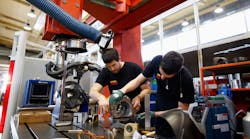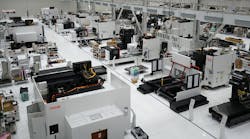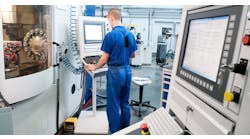Laser cladding and laser welding are different processes, but they serve similar needs: to join materials. There are some peculiarities and benefits to each one, and in some cases professionals can use them in tandem.
Let's take a look at what each process is, and what it offers.
What is laser cladding? — Laser cladding, also called "laser deposition," involves the use of filler material to create a metallurgical bond between a metal substrate and a metal coating. The filler material generally arrives in powder, strip, or wire form and gets introduced to the heat of the laser coaxially or laterally. By using multiple powder types and adjusting the feed rate of each, it's possible to create components deposited with multiple materials or even components with material gradients.
Laser cladding comes into play in a wide variety of industrial tasks — including applying surface coatings, rapid manufacturing and repairing worn-out parts. CO2, Nd:YAG (neodymium-doped yttrium aluminum garnet), and fiber lasers are the three types of lasers in this process, which is useful for several reasons:
• Thanks to the metallurgical bond, there is a low risk of separation and delamination.
• Laser cladding supports a wide variety of material choices, both for the substrate and for the material being deposited.
• There is limited porosity using this method.
• Laser cladding also is a good fit for automation and integration into CNC operations and CAD-based processes.
Choices for deposition material include ferrous metals, such as stainless and carbon steel, plus cobalt- and nickel-based alloys, and aluminum, Inconel and titanium alloys.
Compared with traditional cladding and welding techniques, laser cladding provides a high-speed thermal cycle that makes it possible to achieve higher hardness as well as much finer microstructures — two characteristics that help to resist corrosion.
Laser cladding also offers the benefit of a limited heat-affected zone, which has numerous advantages: It reduces the amount of trauma to the part or workpiece, cuts down on the likelihood of deformations, and allows the process to take place alongside other critical areas that are less tolerant of heat, including adjacent edges and walls. That means laser cladding can add structural reinforcement to sensitive areas.
For an example of laser cladding and its benefits, compare laser-clad screws with nitrided screws. According to the Handbook of Laser Welding Technologies, screws prepared with laser cladding enjoy a service life up to 60% higher than comparable high-alloy nitrided screws.
Heavy industries like oil-and-gas and underground mining are an excellent match for laser cladding — workers commonly use it to resurface cylinder struts, drilling equipment, turbine blades and other critical components. By doing so, they extend the performance life of these critical components and extend the service life of their equipment.
What is laser welding? — Laser welding is a process in which a laser melts two different materials together. It's useful for joining tiny electronic components, as well as larger steel structures. The most common types of lasers used here are CO2 — delivered by mirrors — and Nd:YAG — delivered by fiber optics.
However, thanks to their higher power output, CO2 lasers can join much thicker steel plates — up to 1.5 inches thick — which Nd:YAG lasers cannot do.
Laser welding differs fundamentally from laser cladding in that it does not require a filler material. For applications that require joining dissimilar materials, manufacturers can include an interlayer with IR-absorbing qualities.
Like laser cladding, laser welding also produces a minimal heat-affected zone and little thermal distortion. Other advantages include high-productivity and high-speed operation.
As the laser provides a concentrated source of heat, the joint between the two materials melts and fuses quickly, followed closely by cooling. This makes a manufacturer's choice of materials a critical decision, as these must be able to withstand rapid cooling without cracking.
Laser welding is common in a wide variety of applications, including:
• Electronics packages
• Textiles
• Medical devices
• Window frames
• Signage and visual displays
• Packaging for food and medical products
• Automotive parts
For an example of why someone in manufacturing and/or maintenance hold laser welding in such favorable regard, consider the difference between repairing a mold using laser welding versus tungsten inert gas (TIG) welding. Pulsed-laser welding results in less collateral damage and weakening to the area surrounding the weld. That makes it possible to repair or reuse the mold or other workpiece far more times, and far longer, than workpieces repaired using conventional welding.
Cladding and welding together — Laser welding and laser cladding differ in some substantial ways. They both join two materials, but laser cladding essentially creates a new surface by coating a substrate with another metal. Laser welding, meanwhile, fuses two workpieces.
There are, however, several instances where the two can work in tandem.
One case for combining the two involves the use of "exotic" metallurgy. Some austenitic steel grades and nickel alloys are "exotic" and desirable, thanks to their ability to withstand corrosion in harsh environments. Welding non-naturally occurring exotic materials can be difficult, but using welding and cladding in tandem can help realize the best of both worlds. Laser welding can join two conventional materials prized for their structural properties, while laser cladding can strategically deposit more exotic materials, valuable for their surface properties, at critical junctions or in spots that see heavy wear.
An example is mining truck wheel hubs. Mining companies can breathe new life into these structural components by strategically cladding areas that see the most wear and tear. Welding conventional materials created the structure of the part itself, but aftermarket cladding during maintenance or restoration, using exotic alloys, can help extend its life by imbuing the surface with desirable qualities like corrosion resistance.
Another use case that combines the best of both worlds involves thick plate welding, which usually requires a labor-intensive process called joint prep. But, hybrid laser welding borrows from laser cladding by introducing a filler material which renders a lot of the prep work unnecessary.
These two processes are beneficial separately for a variety of reasons, but they also work well together in certain circumstances. Future developments probably will bring forth even more hybrid methods that combine the most effective features of the two.
Megan Nichols is a STEM writer and blogger covering a wide range of scientific topics at schooledbyscience.com. Recently, she explained How to Optimize Your Metal Fabrication Shop, and offered Quick Tips for Incorporating the IIoT Into Your Machine Shop. Follow Megan on Twitter @nicholsrmegan.








